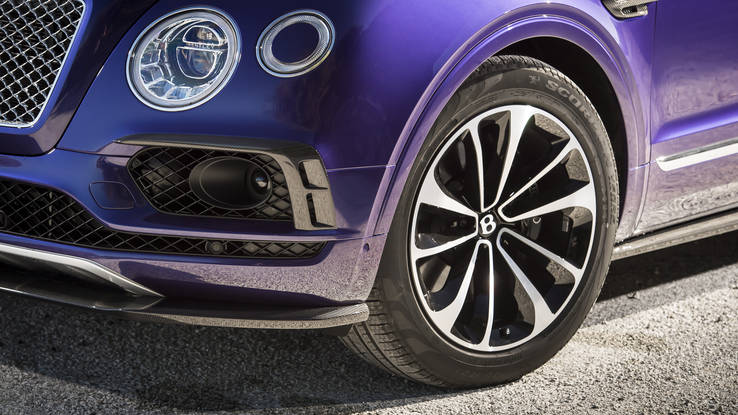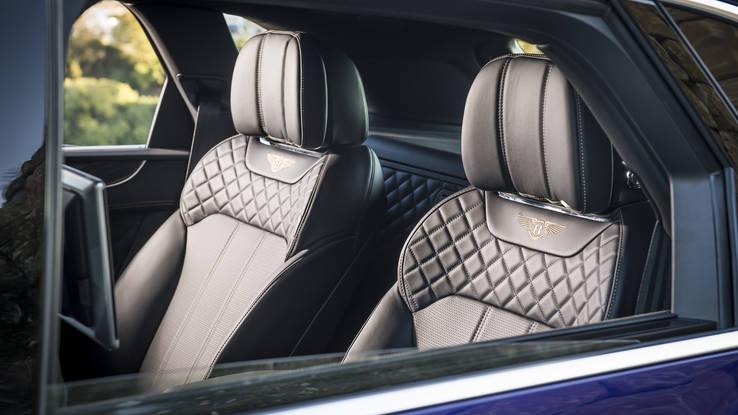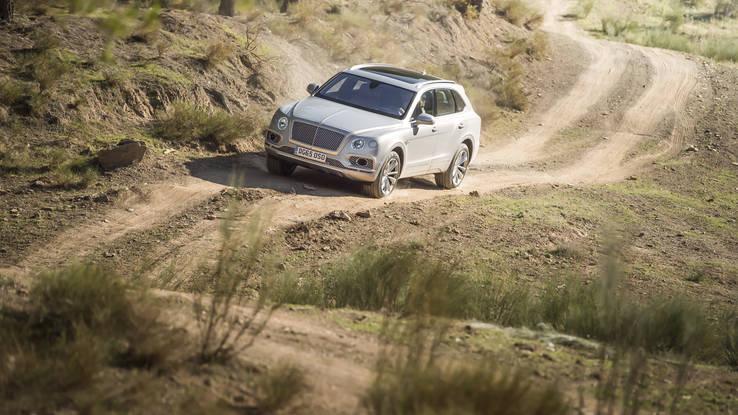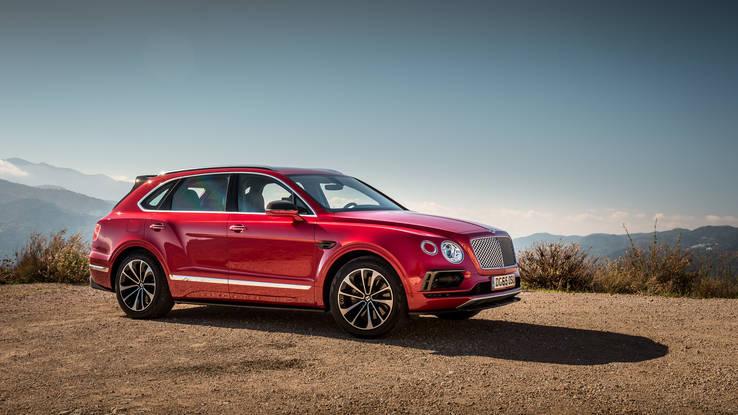Bentley rules the world
What is it?
It’s a winner, guaranteed.
With no hint of reticence, Bentley calls the 2017 Bentayga the “fastest, most powerful, most luxurious and most exclusive SUV in the world.” The Bentayga comes with 600 horsepower, 664 pound-feet of torque and a top speed approaching 200 mph. It can tow 7700 pounds, has four ride heights and nearly 10 inches of ground clearance. It has Tesla-style autonomous driving electronics, the world’s first 48-volt automotive system and 90 separate ECUs processing 100 million lines of code.
Inside are the hides of four cows, 15 separate pieces of veneer, mineral glass gauge covers, milled aluminum accents and tolerances measured in tenths of a millimeter. All this is before options; they can include a self-winding Breitling Mulliner Tourbillon watch in place of the standard timepiece, cast of solid gold with a diamond-studded mother of pearl face, still to be priced but certainly in the hundreds of thousands of dollars. Just for the watch.
This inventory of superlatives provides only part of the reason Bentayga is as surefire as the auto biz can deliver. The rest is that the sky is no longer falling. The Great Recession is mostly a memory and the one percent is buying again. The luxury good sales have risen steadily most everywhere over the last 18 months. The Bentayga debuts right on time and ahead of a brace of higher-than-Range Rover, ultra-lux SUVS (confirmed from Lamborghini and Maserati, widely assumed from Rolls-Royce).
Traditionalists might scoff at the idea of a Bentley SUV, as they did at a BMW or Porsche or Jaguar SUV, but the reality remains: For much of the car-buying world, big, honking SUVs now symbolize success, achievement, status—not some staid coupe or sedan, no matter how many cows the upholstery requires. Car companies built on the idea of demonstrating success, achievement and status can no longer ignore SUVs.
The Bentayga is related to other large SUVs from companies within the VW Group, including the Porsche Cayenne and Audi Q7. But at nearly 17 feet in length the Bentley is longer, wider and heavier than them. Its exterior metal is aluminum, with Bentley’s Superform process (pressed with high-pressure air heated to 950 degrees) producing the sharp creases. Some structural elements are steel for deformation and crash-protection properties. Bentley engineers say the Bentayga’s side panel is the largest single-piece aluminum stamping in the world, and its aluminum intensive build saves 520 pounds compared to all-steel construction.
The roof panel is 60 percent glass. Bentayga’s LED headlights are flush to the surface of the seamless front end, flanking Bentley’s big, bold matrix grille. There’s a familiar power line along each flank, familiar, severe creases in Bentayga’s rear haunches and a B graphic in each split taillight. Wheels measure 20 to 22 inches and an optional Styling Pack adds carbon-fiber body elements. Either way the Bentayga looks like a Bentley—a tall Bentley with optional roof rack.

2017 Bentley Bentayga
Under Bentayga’s hood sits a new 6.0-liter W12—not one part carryover, according to Bentley—better described as two V6s joined at the crank. It has plasma-spray cylinder linings, both port and high-pressure direct injection, three separate water pumps (block, heads, turbos) and four oil pumps. Twin-scroll turbochargers are spun by alternating exhaust pulses from staggered cylinders. The new W12 weighs 70 pounds less than Bentley’s previous 6.0, according to engineers, and it’s built at the Bentley works in Crewe, England.
The 600 brake horsepower peaks flat between 5000 and 6000 rpm. The full 660 lb-ft start at 1350 rpm and hold through 4500. The thrust takes the 5400-pound Bentayga from 0 to 60 mph in four seconds flat, according to Bentley—.1 second quicker than Porsche’s figure for the new-gen 911 Carrera with manual transmission, and half a second quicker than Lexus’s new GS F ultra-performance mid-size sedan. Bentayga’s published 187 mph top speed surpasses both the Porsche and Lexus.
In a nod to efficiency, the new W12 is equipped with a start/stop feature and variable displacement technology. Six of the 12 cylinders shut down during steady-throttle operation if torque demand is below 220 lb-ft.
All Bentaygas get an eight-speed ZF automatic and permanent, variable all-wheel drive with a Torsen center differential. The optional All-Terrain Pack adds four off-road specific drive modes, hill-decent control and a range of skid plates.
The Bentayga is suspended with self-leveling air springs and adaptive shocks. Yet the big news in the chassis is Bentley Dynamic Ride, similar in objective to active roll management systems from BMW and Mercedes-Benz, and key to the Bentayga’s balanced suspension performance on- or off-road. On road, BDR manipulates the anti-roll bars to counteract lateral roll force and keep Bentayga’s mass level as speed builds. It works independently front and rear and at each wheel. Off-road, BDR effectively de-couples the sway bars to allow full wheel travel exceeding nine inches.
The new development? Rather than using hydraulics to torque the sway bars, as in previous active roll management systems, Bentley uses electric motors. Engineers say the motors react three times faster, in more finite increments. They’re powered by 48 volts of electromotive force, up-converted from the 12-volt charging system and stored in a super capacitor with enough reserve to complete full-bore laps around the 13-mile Nürburgring. Rolf Frech, Bentley’s board member for engineering, expects introducing 48 volts in Bentayga will spark more applications across the auto industry, including electrically operated turbos.
Bentayga buyers can choose either four or five seats. Five means a folding rear bench, while four puts two buckets in back–identical to the standard 18-adjustment front seats and separated by a console, with a diamond-stitched leather partition in front of the cargo area. Both configurations come with a touch pad for rear climate and infotainment adjustments. It can be removed from the back of the front console and held on the lap so there’s no need to lean forward to adjust temperature or fan speed.

2017 Bentley Bentayga
Generally the Bentayga has better accommodations than a Continental GT or Flying Spur for things like muddy Hunter wellies, and more SUV stuff. This includes modular storage systems, pet cages and a tailgate Event Seat. The queen might be the Mulliner Hamper—a picnic kit with three leather-upholstered cubes, removable from the cargo space and used as seats. One is filled with Linley china, cutlery and crystal. Another is for dry goods and the third is refrigerated, for Dom and beluga.
There’s a ton of stuff, of course, from state of the art electronics to jewelry like the Tourbillon. An invisible metallic layer, also acting as a UV filter, heats the double-pane windscreen. There are 12 exterior ultrasonic sensors, five cameras with a composite top view, long-and short-distance radar, traffic sign recognition, night vision, head-up display and park assist–which works with a trailer attached. The Android tablets delivering rear-seat video can be removed from behind the front headrests for full computer functionality. There’s a 60-gig onboard hard-drive and three audio systems, from the standard 700 watts to the 1800-watt Naim.
The Bentayga has undergone the most rigorous testing in Bentley history according to the company: more than a million road miles on five continents in temperatures from -22 to 125 F; more than 400 tuning laps around the Nürburgring. It’s the first Bentley subjected to towing tests. All electronic and mechanical systems are validated for full function when the vehicle is inclined 35 degrees in any direction. Top speed is validated at 105 F. ambient with no degradation in cooling capacity.
It takes 130 hours to build—compared to about ten for a mainstream mid-size sedan—before bespoke personalization. The paint is hand applied and polished. Hides are cut and sewn at Crewe and a dedicated staff of 58 hand fashion and finish the wood veneers. The factory has undergone a $ 1.2 billion dollar upgrade anticipating production.
The first customer Bentaygas start the process Nov. 27, and you can order yours now at $ 229,100 before delivery or options. Buyers who signed a purchase contract before the Bentayga was released get a special edition Breitling sport watch with GPS tracking.
Bentayga purchasers should be equally first-time Bentley buyers and people who already own Bentleys according to the company (the typical U.S. Bentley owner has nine cars). The value of being first into the above-Range Rover SUV market should not be underestimated. To some extent Bentayga defines expectations. By the time Lambo or Maserati or whoever else jumps in, Bentley will be ready with a diesel engine and possibly another, unspecified Bentayga variant CEO Wolfgang Durheimer says is already underway.
Love it or hate it, the Bentayga won’t fail. Don’t take our word for it: Durheimer says the business plan is built on 3,500 sales annually, but pre-orders and queries suggest Bentley can sell 5,500 the first full year if it can build them.
The company will sell at least 10,000 cars for the third straight year in 2015 and enjoy its most profitable year ever, according to Durheimer—even with China in recession (now Bentley’s third largest market, behind the United States and Western Europe). The point in the Bentayga context is obvious.
If the rest of the line holds steady for 2016, Bentayga should account for more than a third of all Bentley sales by the end of its first year.

2017 Bentley Bentayga
How’s it drive?
Like the Bentley of SUVs, all bases covered. Bentley boasts with Bentayga, “Ultra-luxury no longer ends where the road does.” Range Rover might take offense, but the assertion certainly applies to Bentley’s new SUV.
What’s to say about the W12 that output figures don’t already imply? Maybe that it’s also exceptionally smooth, with anything like a roar reserved only for full-throttle operation. There’s enough thrust to get an airliner to rotation speed. Nothing in a road test suggests Bentley’s 0-60 mph time is off the mark, and that says a lot. What it doesn’t say is, there’s no sweat, no fury, in the process–no troublesome noises or rough edges. Just plant the gas pedal and the Bentayga flies toward the horizon—any gear, any road speed—in smooth, composed serenity, no issue with stability or mass.
There’s a bit more firmness in the ride compared to a Spur, maybe, and definitely more wind noise than in a Mulsanne. Yet Bentayga is the first Bentley that literally drives itself. Engage lane keeping and the adaptive cruise control on the motorway or a fast B-road, and the Bentayga tracks curves, adjusts speed to maintain appropriate spacing and slows immediately if whatever’s ahead dictates such—all without driver participation. Autonomous operation is supposed to work only when the driver is attentive, and safely disengages after a warning if he or she isn’t. Yet the failsafe senses a bit of weight (a hand) on the steering wheel. It can be defeated by hanging something—how about an open wallet?—over the wheel rim.
The Bentayga easily performs the obligatory off-road stunts. Maybe a few dozen owners outside of the Middle East will actually try them. Rutted, 35-degree grades are no problem, and they demand little technique thanks to the control electronics. There’s good underbody protection, and given the massive low-rev torque, a low range is almost silly. The more remarkable thing might be that a Bentley can camel its way over rocks and whoopee-dos. Even if an owner’s off-road excursions are limited to the dirt trail back to the polo grounds, not something one would consider undertaking in a Mulsanne.
The most remarkable thing might be driving the crap out of 5400 two-box pounds of Bentayga on twisting mountain roads in Andalucía, Spain.
The Bentayga’s four on-road drive modes are labeled Comfort, Sport, Custom—and Bentley. How great is that? Shouldn’t a 488GTB’s Mannetino dial say Sport, Sport + and Ferrari? Bentley mode says “you can set this however you want, but we know what’s best.” In operation it sets parameters somewhere between sport and comfort and it’s what the engineers who developed Bentayga would use as the default. Still, it’s the full sport setting that most obviously validates the Bentley Dynamic Ride roll-management system.
We’re not sure it’s exactly fun slamming a Bentayga through slow curves and switchbacks, but its stunning to anyone who remembers driving a 1980s Chevy Suburban—or even a 2015. The active anti-roll bars keep close to three tons of tall Bentley bizarrely level and stable as lateral g increases. Steering feel builds with the load, and the suspension works to isolate the tires as the sole determinant of lateral grip. It’s big, high and heavy, of course, but as well managed as big, high and heavy can be. It’s no problem making passengers queasy if the driver has a cruel streak.
Is the Bentayga a Cayenne Turbo S in the twisties? Not exactly, but it can get close if you want it too. And you get Bentley, not Porsche, inside. The inspiration of Bentley’s wing logo is obvious in the dash layout. It’s comforting and maybe even timeless. Craftsmanship, time and cost are visible everywhere, with any of the standard 15 leather colors or seven veneer options.

2017 Bentley Bentayga
Do I want it?
Almost certainly, though it’s possible you want the existing Cayenne Turbo S or the forthcoming Lamborghini SUV more. Blazing a trail to SUV price points well north of Range Rover is not an exact science. Whether you want the Bentayga or not, there are more than enough one-percenters who do.
The 2017 Bentayga is not quite the eye-opener the Continental GT coupe was when it was introduced in 2003, launching Bentley’s march from irrelevance back to prominence. The Bentayga is more what industry insiders have been expecting. Yet it’s an even better fit than the Continental GT for today’s marketplace and exactly what the first Bentley SUV should be.




























